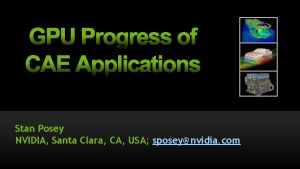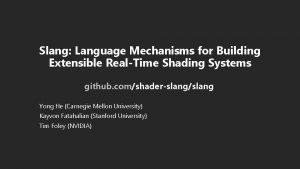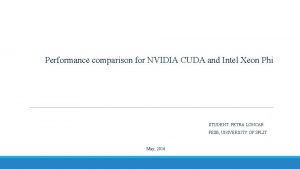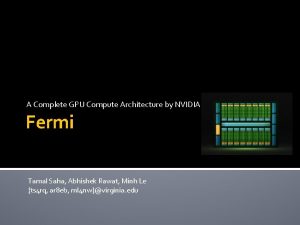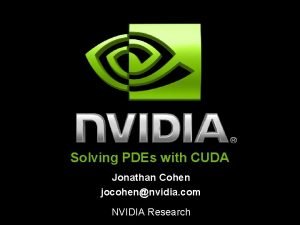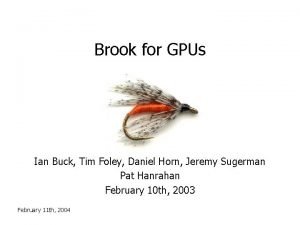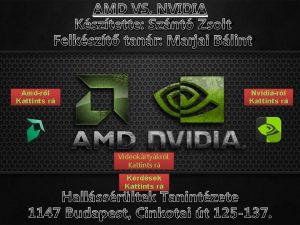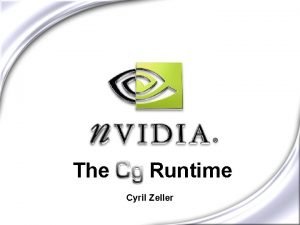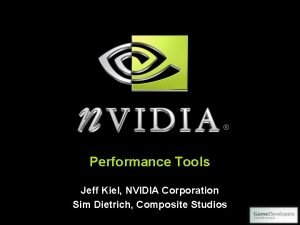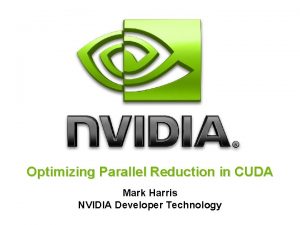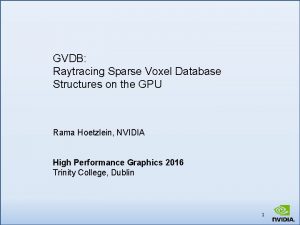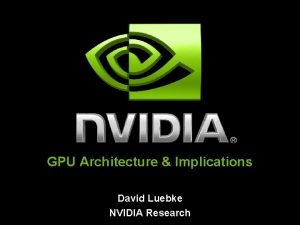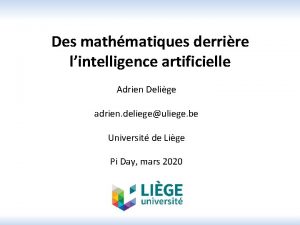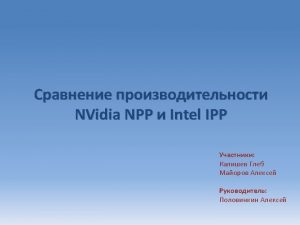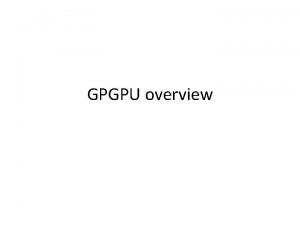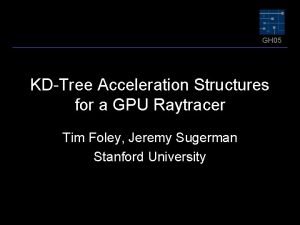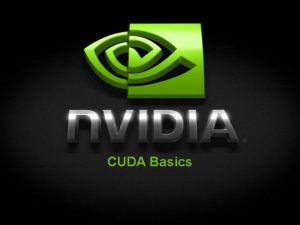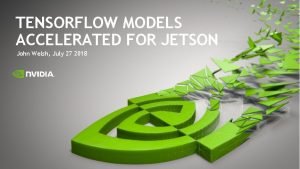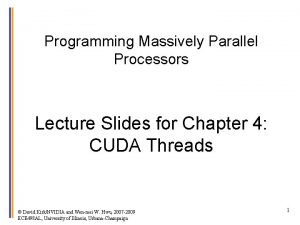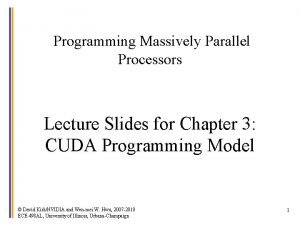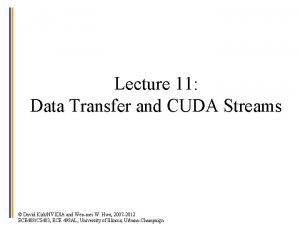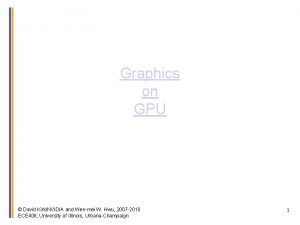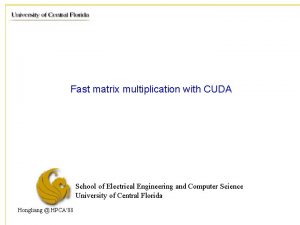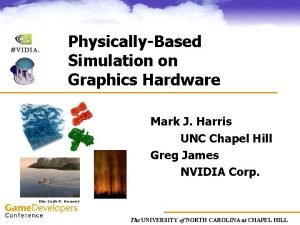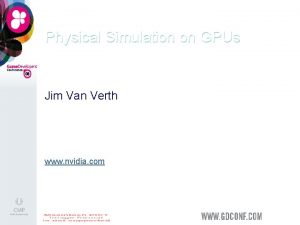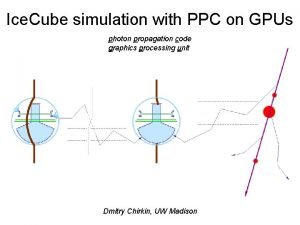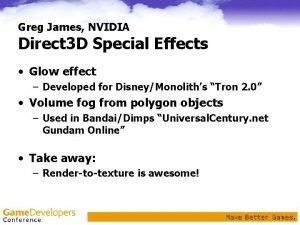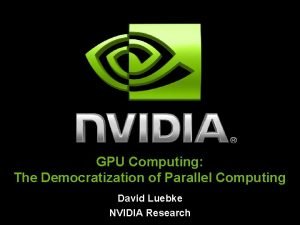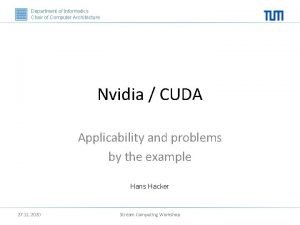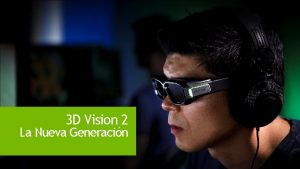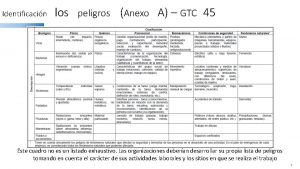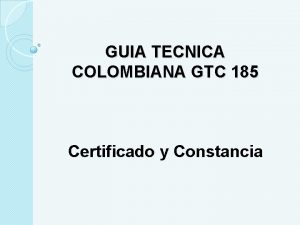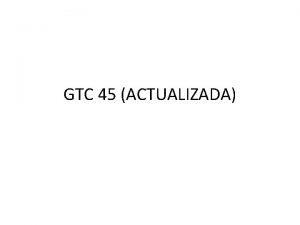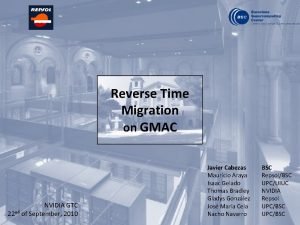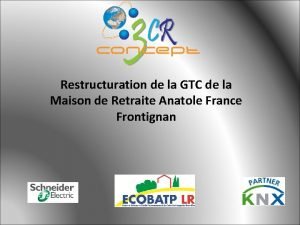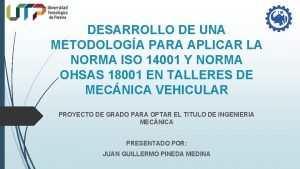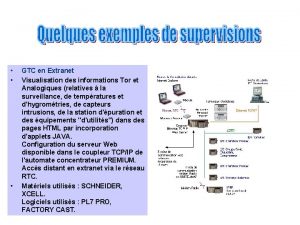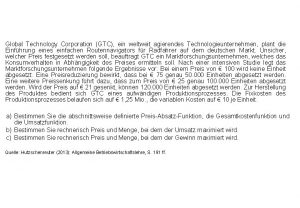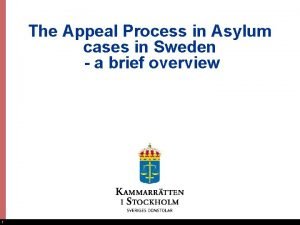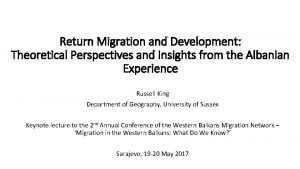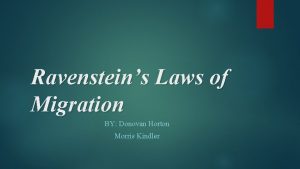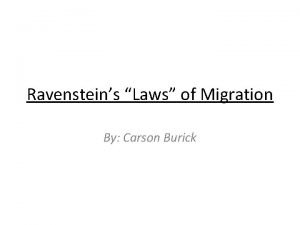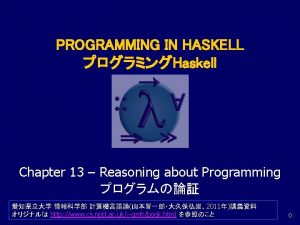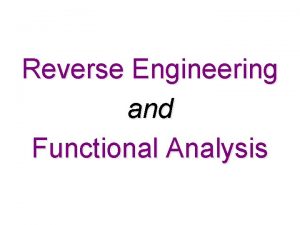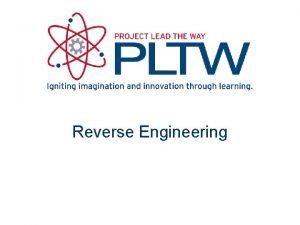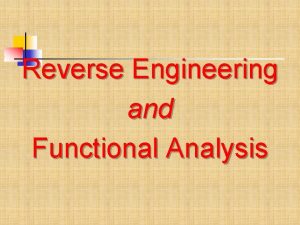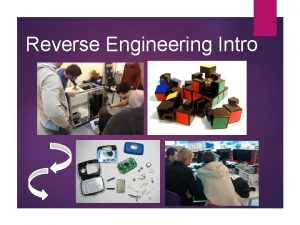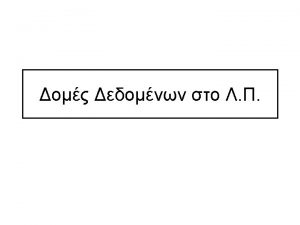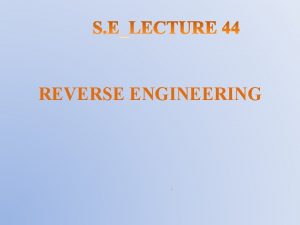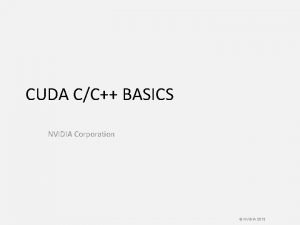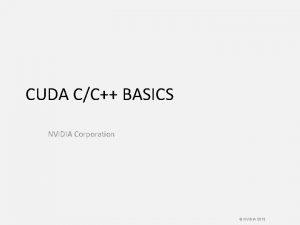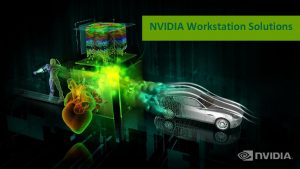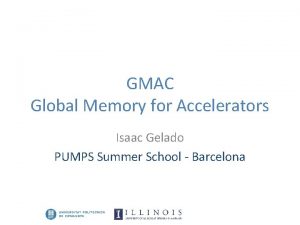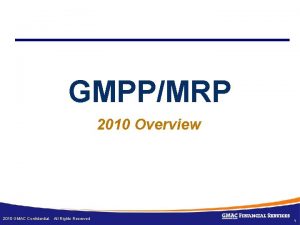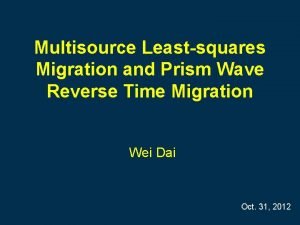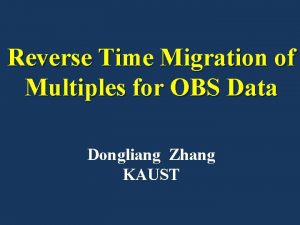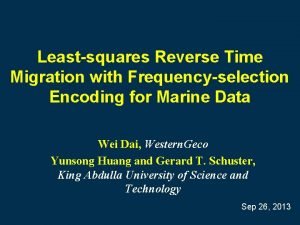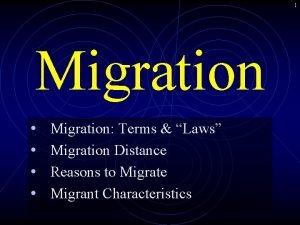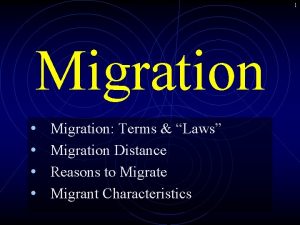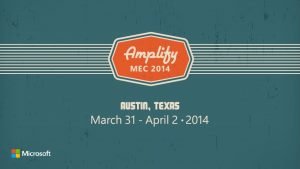Reverse Time Migration on GMAC NVIDIA GTC 22
























































- Slides: 56

Reverse Time Migration on GMAC NVIDIA GTC 22 nd of September, 2010 Javier Cabezas Mauricio Araya Isaac Gelado Thomas Bradley Gladys González José María Cela Nacho Navarro BSC Repsol/BSC UPC/UIUC NVIDIA Repsol UPC/BSC

Outline • Introduction • Reverse Time Migration on CUDA • GMAC at a glance • Reverse Time Migration on GMAC • Conclusions NVIDIA GPU Technology Conference – 22 nd of September, 2010 2

Reverse Time Migration on CUDA └ RTM • RTM generates an image of the subsurface layers • Uses traces recorded by sensors in the field • RTM’s algorithm 1. Propagation of a modeled wave (forward in time) 2. Propagation of the recorded traces (backward in time) 3. Correlation of the forward and backward wavefields • Last forward wavefield with the first backward wavefield • FDTD are preferred to FFT • • 2 nd-order finite differencing in time High-order finite differencing in space NVIDIA GPU Technology Conference – 22 nd of September, 2010 3

Introduction └ Barcelona Supercomputing Center (BSC) • BSC and Repsol: Kaleidoscope project • • Develop better algorithms/techniques for seismic imaging We focused on Reverse Time Migration (RTM), as it is the most popular seismic imaging technique for depth exploration • Due to the high computational power required, the project started a quest for the most suitable hardware • • Power. PC: scalability issues Cell: good performance (in production @ Repsol), difficult programmability FPGA: potentially best performance, programmability nightmare GPUs: 5 x speedup vs Cell (GTX 280), what about programmability? NVIDIA GPU Technology Conference – 22 nd of September, 2010 4

Outline • Introduction • Reverse Time Migration on CUDA →General approach • Disk I/O • Domain decomposition • Overlapping computation and communication • GMAC at a glance • Reverse Time Migration on GMAC • Conclusions NVIDIA GPU Technology Conference – 22 nd of September, 2010 5

Reverse Time Migration on CUDA └ General approach • We focus on the host-side part of the implementation 1. Avoid memory transfers between host and GPU memories • Implement on the GPU as many computations as possible • Overlap memory transfers and kernel execution • Overlap device. To. Host and host. To. Device memory transfers 2. Hide latency of memory transfers 3. Take advantage of the PCIe full-duplex capabilities (Fermi) NVIDIA GPU Technology Conference – 22 nd of September, 2010 6

Reverse Time Migration on CUDA └ General approach Forward Backward 3 D-Stencil Absorbing Boundary Conditions Source insertion Traces insertion Compression Read from disk Write to disk Decompression Correlation NVIDIA GPU Technology Conference – 22 nd of September, 2010 7

Reverse Time Migration on CUDA └ General approach • Data structures used in the RTM algorithm • • Read/Write structures • • • 3 D volume for the wavefield (can be larger than 1000 x 1000 points) State of the wavefiled in previous time-steps to compute finite differences in time Some extra points in each direction at the boundaries (halos) Read-Only structures • • 3 D volume of the same size as the wavefield Geophones’ recorded traces: time-steps x #geophones NVIDIA GPU Technology Conference – 22 nd of September, 2010 8

Reverse Time Migration on CUDA └ General approach • Data flow-graph (forward) 3 D-Stencil ABC Source Wavefields Constant read-only data: velocity model, geophones’ traces NVIDIA GPU Technology Conference – 22 nd of September, 2010 9 Compress

Reverse Time Migration on CUDA └ General approach • Simplified data flow-graph (forward) RTM Kernel Compress Wave-fields Constant read-only data: velocity model, geophones’ traces NVIDIA GPU Technology Conference – 22 nd of September, 2010 10

Reverse Time Migration on CUDA └ General approach Start • Control flow-graph (forward) • • i =0 RTM Kernel Computation RTM Kernel Compress and transfer to disk • • • device. To. Host + Disk I/O Performed every N steps Can run in parallel with the next compute steps i%N == 0 yes Compress no to. Host i++ Runs on the GPU Runs on the CPU yes i < steps no End NVIDIA GPU Technology Conference – 22 nd of September, 2010 11 Disk I/O

Outline • Introduction • Reverse Time Migration on CUDA • General approach →Disk I/O • Domain decomposition • Overlapping computation and communication • GMAC at a glance • Reverse Time Migration on GMAC • Conclusions NVIDIA GPU Technology Conference – 22 nd of September, 2010 12

Reverse Time Migration on CUDA └ Disk I/O • GPU → Disk transfers are very time-consuming K 1 K 2 K 3 K 4 C to. Host K 5 Disk I/O time • Transferring to disk can be overlapped with the next (computeonly) steps K 1 K 2 K 3 K 4 C Runs on the GPU to. Host Runs on the CPU time NVIDIA GPU Technology Conference – 22 nd of September, 2010 K 5 13 K 6 Disk I/O K 7 K 8

Reverse Time Migration on CUDA └ Disk I/O • Single transfer: wait for all the data to be in host memory device. To. Host Disk I/O time • Multiple transfers: overlap device. To. Host transfers with disk I/O • to. H Double buffering to. H Disk I/O time NVIDIA GPU Technology Conference – 22 nd of September, 2010 14 Disk I/O

Reverse Time Migration on CUDA └ Disk I/O • CUDA-RT limitations • GPU memory accessible by the owner host thread only →device. To. Host transfers must be performed by the compute thread GPU address space Compute thread I/O thread CPU address space NVIDIA GPU Technology Conference – 22 nd of September, 2010 15

Reverse Time Migration on CUDA └ Disk I/O • CUDA-RT Implementation (single transfer) • CUDA streams must be used not to block GPU execution →Intermediate page-locked buffer must be used: for real-size problems the system can run out of memory! GPU address space CPU address space NVIDIA GPU Technology Conference – 22 nd of September, 2010 16

Reverse Time Migration on CUDA └ Disk I/O • CUDA-RT Implementation (multiple transfers) • Besides launching kernels, the compute thread must program and monitor several device. To. Host transfers while executing the next compute-only steps on the GPU →Lots of synchronization code in the compute thread GPU address space CPU address space NVIDIA GPU Technology Conference – 22 nd of September, 2010 17

Outline • Introduction • Reverse Time Migration on CUDA • General approach • Disk I/O →Domain decomposition • Overlapping computation and communication • GMAC at a glance • Reverse Time Migration on GMAC • Conclusions NVIDIA GPU Technology Conference – 22 nd of September, 2010 18

Reverse Time Migration on CUDA └ Domain decomposition • But… wait, real-size problems require > 16 GB of data! • Volumes are split into tiles (along the Z-axis) • 3 D-Stencil introduces data dependencies D 4 D 2 x y z D 1 NVIDIA GPU Technology Conference – 22 nd of September, 2010 D 3 19

Reverse Time Migration on CUDA └ Domain decomposition • Multi-node may be required to overcome memory capacity limitations • • Shared memory for intra-node communication MPI for inter-node communication Node 2 Node 1 GPU 2 GPU 3 GPU 4 GPU 1 GPU 2 MPI Host Memory NVIDIA GPU Technology Conference – 22 nd of September, 2010 Host Memory 20 GPU 3 GPU 4

Reverse Time Migration on CUDA └ Domain decomposition • Data flow-graph (multi-domain) RTM Kernel Compress RTM Kernel Wave-fields (domain 1) Wave-fields (domain 2) Constant read-only data: velocity model, geophones’ traces NVIDIA GPU Technology Conference – 22 nd of September, 2010 21

Reverse Time Migration on CUDA └ Domain decomposition Start • Control flow-graph (multi-domain) • i =0 Boundary exchange every time-step • Kernel sync Inter-domain communication blocks execution of the next steps! Exchange s%N == 0 yes Compress no to. Host i++ Runs on the GPU Runs on the CPU yes i < steps no End NVIDIA GPU Technology Conference – 22 nd of September, 2010 22 Disk I/O

Reverse Time Migration on CUDA └ Domain decomposition • Boundary exchange every time-step is needed K 1 X K 2 X K 3 X K 4 X C K 5 X K 6 to. Host Disk I/O time NVIDIA GPU Technology Conference – 22 nd of September, 2010 23 X K 7

Reverse Time Migration on CUDA └ Domain decomposition • Single-transfer exchange • “Easy” to program, needs large page-locked buffers device. To. Host host. To. Device time • Multiple-transfer exchange to maximize PCI-Express utilization • to. H “Complex” to program, needs smaller page-locked buffers to. H to. D to. D time NVIDIA GPU Technology Conference – 22 nd of September, 2010 24 to. D

Reverse Time Migration on CUDA └ Domain decomposition • CUDA-RT limitations • Each host thread can only access to the memory objects it allocates GPUs’ address spaces GPU 1 GPU 2 GPU 3 CPU address space NVIDIA GPU Technology Conference – 22 nd of September, 2010 25 GPU 4

Reverse Time Migration on CUDA └ Domain decomposition • CUDA-RT implementation (single-transfer exchange) • • Streams and page-locked memory buffers must be used Page-locked memory buffers can be too big GPUs’ address spaces GPU 1 GPU 2 GPU 3 CPU address space NVIDIA GPU Technology Conference – 22 nd of September, 2010 26 GPU 4

└ Domain decomposition • CUDA-RT implementation (multiple-transfer exchange) • • Uses small page-locked buffers More synchronization code • Too complex to be represented using Powerpoint! • Very difficult to implement in real code! NVIDIA GPU Technology Conference – 22 nd of September, 2010 27

Outline • Introduction • Reverse Time Migration on CUDA • General approach • Disk I/O • Domain decomposition →Overlapping computation and communication • GMAC at a glance • Reverse Time Migration on GMAC • Conclusions NVIDIA GPU Technology Conference – 22 nd of September, 2010 28

Reverse Time Migration on CUDA └ Overlapping computation and communication • Problem: boundary exchange blocks the execution of the following time-step K 1 X K 2 X K 3 X K 4 X C K 5 X K 6 to. Host Disk I/O time NVIDIA GPU Technology Conference – 22 nd of September, 2010 29 X K 7

Reverse Time Migration on CUDA └ Overlapping computation and communication • Solution: with a 2 -stage execution plan we can effectively overlap the boundary exchange between domains k 1 K 1 X k 2 K 2 X k 3 K 3 k 4 X K 4 X C k 5 K 5 X k 6 K 6 X to. Host NVIDIA GPU Technology Conference – 22 nd of September, 2010 30 K 7 X k 8 K 8 X C k 9 K 9 X to. Host Disk I/O time k 7 Disk I/O

Reverse Time Migration on CUDA └ Overlapping computation and communication • Approach: two-stage execution • Stage 1: compute the wavefield points to be exchanged x y z GPU 1 NVIDIA GPU Technology Conference – 22 nd of September, 2010 GPU 2 31

Reverse Time Migration on CUDA └ Overlapping computation and communication • Approach: two-stage execution • Stage 2: Compute the remaining points while exchanging the boundaries x y z GPU 1 NVIDIA GPU Technology Conference – 22 nd of September, 2010 GPU 2 32

Reverse Time Migration on CUDA └ Overlapping computation and communication • But two-stage execution requires more abstractions and code complexity • An additional stream per domain • We already have 1 to launch kernels, 1 to overlap transfers to disk, 1 to exchange boundaries →At this point the code is a complete mess! • Requires 4 streams per domain, many page-locked buffers, lots of inter -thread synchronization • • Poor readability and maintainability Easy to introduce bugs NVIDIA GPU Technology Conference – 22 nd of September, 2010 33

Outline • Introduction • Reverse Time Migration on CUDA • GMAC at a glance →Features • Code examples • Reverse Time Migration on GMAC • Conclusions NVIDIA GPU Technology Conference – 22 nd of September, 2010 34

GMAC at a glance └ Introduction • Library that enhances the host programming model of CUDA • Freely available at http: //code. google. com/p/adsm/ • • • Developed by BSC and UIUC NCSA license (BSD-like) Works in Linux and Mac. OS X (Windows version coming soon) • Presented in detail tomorrow at 9 am @ San Jose Ballroom NVIDIA GPU Technology Conference – 22 nd of September, 2010 35

GMAC at a glance └ Features • Unified virtual address space for all the memories in the system • Single allocation for shared objects • Special API calls: gmac. Malloc, gmac. Free • GPU memory allocated by a host thread is visible to all host threads →Brings POSIX thread semantics back to developers Shared Data GPU CPU Data NVIDIA GPU Technology Conference – 22 nd of September, 2010 Memory 36

GMAC at a glance └ Features • Parallelism exposed via regular POSIX threads • • Replaces the explicit use of CUDA streams Open. MP support • GMAC uses streams and page-locked buffers internally • Concurrent kernel execution and memory transfers for free GPU NVIDIA GPU Technology Conference – 22 nd of September, 2010 37

GMAC at a glance └ Features • Optimized bulk memory operations via library interposition • • • File I/O • • Standard I/O functions: fwrite, fread Automatic overlap of Disk I/O and host. To. Device and device. To. Host transfers Optimized GPU to GPU transfers via regular memcpy Enhanced versions of the MPI send/receive calls NVIDIA GPU Technology Conference – 22 nd of September, 2010 38

Outline • Introduction • Reverse Time Migration on CUDA • GMAC at a glance • Features →Code examples • Reverse Time Migration on GMAC • Conclusions NVIDIA GPU Technology Conference – 22 nd of September, 2010 39

GMAC at a glance └ Examples • Single allocation (and pointer) for shared objects CUDA-RT GMAC void compute(FILE *file, int size) { 1 float *foo, *dev_foo; 2 foo = malloc(size); 3 fread(foo, size, 1, file); 4 cuda. Malloc(&dev_foo, size); 5 cuda. Memcpy(dev_foo, size, To. Device); 6 kernel<<<Dg, Db>>>(dev_foo, size); 7 cuda. Thread. Synchronize(); 8 cuda. Memcpy(foo, dev_foo, size, To. Host); 9 cpu. Computation(foo); 10 cuda. Free(dev_foo); 11 free(foo); } NVIDIA GPU Technology Conference – 22 nd of September, 2010 40 void compute(FILE *file, int size) { 1 float *foo; 2 foo = gmac. Malloc(size); 3 fread(foo, size, 1, file); 4 5 6 kernel<<<Dg, Db>>>(foo, size); 7 gmac. Thread. Synchronize(); 8 9 cpu. Computation(foo); 10 gmac. Free(foo); 11 }

GMAC at a glance └ Examples • Optimized support for bulk memory operations CUDA-RT GMAC void compute(FILE *file, int size) { 1 float *foo, *dev_foo; 2 foo = malloc(size); 3 fread(foo, size, 1, file); 4 cuda. Malloc(&dev_foo, size); 5 cuda. Memcpy(dev_foo, size, To. Device); 6 kernel<<<Dg, Db>>>(dev_foo, size); 7 cuda. Thread. Synchronize(); 8 cuda. Memcpy(foo, dev_foo, size, To. Host); 9 cpu. Computation(foo); 10 cuda. Free(dev_foo); 11 free(foo); } NVIDIA GPU Technology Conference – 22 nd of September, 2010 41 void compute(FILE *file, int size) { 1 float *foo; 2 foo = gmac. Malloc(size); 3 fread(foo, size, 1, file); 4 5 6 kernel<<<Dg, Db>>>(foo, size); 7 gmac. Thread. Synchronize(); 8 9 cpu. Computation(foo); 10 gmac. Free(foo); 11 }

Outline • Introduction • GMAC at a glance • Reverse Time Migration on GMAC →Disk I/O • Domain decomposition • Overlapping computation and communication • Development cycle and debugging • Conclusions NVIDIA GPU Technology Conference – 22 nd of September, 2010 42

Reverse Time Migration on GMAC └ Disk I/O • CUDA-RT Implementation (multiple transfers) • Besides launching kernels, the compute thread must program and monitor several device. To. Host transfers while executing the next compute-only steps on the GPU →Lots of synchronization code in the compute thread GPU address space CPU address space NVIDIA GPU Technology Conference – 22 nd of September, 2010 43

Reverse Time Migration on GMAC └ Disk I/O (GMAC) • GMAC implementation • • • device. To. Host transfers performed by the I/O thread device. To. Host and Disk I/O transfers overlap for free Small page-locked buffers are used GPU Global address space NVIDIA GPU Technology Conference – 22 nd of September, 2010 44

Outline • Introduction • GMAC at a glance • Reverse Time Migration on GMAC • Disk I/O →Domain decomposition • Overlapping computation and communication • Development cycle and debugging • Conclusions NVIDIA GPU Technology Conference – 22 nd of September, 2010 45

Reverse Time Migration on GMAC └ Domain decomposition (CUDA-RT) • CUDA-RT implementation (single-transfer exchange) • • Streams and page-locked memory buffers must be used Page-locked memory buffers can be too big GPUs’ address spaces GPU 1 GPU 2 GPU 3 CPU address space NVIDIA GPU Technology Conference – 22 nd of September, 2010 46 GPU 4

Reverse Time Migration on GMAC └ Domain decomposition (GMAC) • GMAC implementation (multiple-transfer exchange) • Exchange of boundaries performed using a simple memcpy! GPU 1 GPU 2 GPU 3 GPU 4 Unified global address space • Full PCIe utilization: internally GMAC performs several transfers and double buffering NVIDIA GPU Technology Conference – 22 nd of September, 2010 47

Outline • Introduction • GMAC at a glance • Reverse Time Migration on GMAC • Disk I/O • Domain decomposition →Overlapping computation and communication • Development cycle and debugging • Conclusions NVIDIA GPU Technology Conference – 22 nd of September, 2010 48

Reverse Time Migration on GMAC └ Overlapping computation and communication • No streams, no page-locked buffers, similar performance: ± 2% fread(velocity); gmac. Malloc(&input, W_SIZE); gmac. Malloc(&output, W_SIZE); read. Velocity(velociy); cuda. Malloc(&d_input, W_SIZE); cuda. Malloc(&d_output, W_SIZE); cuda. Host. Alloc(&i_halos, H_SIZE); cuda. Host. Alloc(&disk_buffer, W_SIZE); cuda. Stream. Create(&s 1); cuda. Stream. Create(&s 2); cuda. Memcpy(d_velocity, W_SIZE) for all time steps do launch_stage 1(d_output, d_input, s 1); launch_stage 2(d_output, d_input, s 2); cuda. Memcpy. Async(i_halos, d_output, s 1); cuda. Stream. Synchronize(s 1); barrier(); cuda. Memcpy. Async(d_output, i_halos, s 1); cuda. Thread. Synchronize(); barrier(); if (timestep % N == 0) { compress(output, c_output); transfer_to_host(disk_buffer); barrier_write_to_disk(); } //. . . Update pointers end for all time steps do launch_stage 1( output, input ); gmac. Thread. Synchronize(); launch_stage 2( output, input ); memcpy(neighbor, output); gmac. Thread. Synchronize(); barrier(); if (timestep % N == 0) { compress(output, c_output); barrier_write_to_disk(); } //. . . Update pointers end for CUDA-RT NVIDIA GPU Technology Conference – 22 nd of September, 2010 GMAC 49

Outline • Introduction • GMAC at a glance • Reverse Time Migration on GMAC • Disk I/O • Domain decomposition • Inter-domain communication →Development cycle and debugging • Conclusions NVIDIA GPU Technology Conference – 22 nd of September, 2010 50

Reverse Time Migration on GMAC └ Development cycle and debugging • CUDA-RT • • Start from a simple, correct sequential code Implement kernels one at a time and check correctness • • • 3 D-Stencil Two allocations per data structure Source insertion Keep data consistency by hand (cuda. Memcpy) To introduce modifications to any kernel • • Absorbing Boundary Conditions Two allocations per data structure Keep data consistency by hand (cuda. Memcpy) NVIDIA GPU Technology Conference – 22 nd of September, 2010 51 Compression

Reverse Time Migration on GMAC └ Development cycle and debugging • GMAC • • 3 D-Stencil Allocate objects with gmac. Malloc • Single pointer Use pointer both in the host and GPU kernel implementations • Absorbing Boundary Conditions Source insertion No copies Compression NVIDIA GPU Technology Conference – 22 nd of September, 2010 52

Outline • Introduction • Reverse Time Migration on CUDA • GMAC at a glance • Reverse Time Migration on GMAC • Conclusions NVIDIA GPU Technology Conference – 22 nd of September, 2010 53

Conclusions • Heterogeneous systems based on GPUs are currently the most appropriate to implement RTM • CUDA has programmability issues • • CUDA provides a good language to expose data parallelism in the code to be run on the GPU The host-side interface provided by the CUDA-RT makes difficult to implement even some basic optimizations ØGMAC eases the development of applications for GPU-based systems with no performance penalty Ø 6 -month part-time single programmer: full RTM version (5 x speedup over the previous Cell implementation) NVIDIA GPU Technology Conference – 22 nd of September, 2010 54

Acknowledgements • Barcelona Supercomputing Center • Repsol • Universitat Politècnica de Catalunya • University of Illinois at Urbana-Champaign NVIDIA GPU Technology Conference – 22 nd of September, 2010 55

Thank you! Questions? NVIDIA GPU Technology Conference – 22 nd of September, 2010 56
 Santa clara county
Santa clara county Language
Language Nvidia cuda comparison
Nvidia cuda comparison Gpu architecture basics
Gpu architecture basics Sony imageworks
Sony imageworks Ian buck nvidia
Ian buck nvidia Videokártya feladata
Videokártya feladata Cg compiler
Cg compiler Sim dietrich
Sim dietrich Parallel reduction cuda
Parallel reduction cuda Gvdb nvidia
Gvdb nvidia Nvidia
Nvidia Nvidia gaugan beta
Nvidia gaugan beta Tim foley net worth
Tim foley net worth Image.transpose
Image.transpose Nvidia gc6 gc off
Nvidia gc6 gc off Nvidia cache
Nvidia cache Tim foley nvidia
Tim foley nvidia Datacuda inc
Datacuda inc John welsh nvidia
John welsh nvidia David kirk nvidia
David kirk nvidia Massively parallel processing ppt
Massively parallel processing ppt Cudagetdevicecount(&device_count)
Cudagetdevicecount(&device_count) David kirk nvidia
David kirk nvidia Fast matrix multiplication
Fast matrix multiplication Nvidia optimal power vs adaptive
Nvidia optimal power vs adaptive Mark harris nvidia
Mark harris nvidia Jimmy daley nvidia
Jimmy daley nvidia Nvidia ppc
Nvidia ppc Greg from nvidia
Greg from nvidia Michael garland nvidia
Michael garland nvidia Nvidia chair
Nvidia chair Mision y vision de nvidia
Mision y vision de nvidia Elapsed time
Elapsed time Anexo a gtc45
Anexo a gtc45 Que es la gtc 185 y como aplicarla
Que es la gtc 185 y como aplicarla Gtc 45 actualizada 2021
Gtc 45 actualizada 2021 Gtc 22
Gtc 22 Gtc definition
Gtc definition Gtc scotland registration
Gtc scotland registration Gtc meaning in school
Gtc meaning in school Gtc 45 anexo a
Gtc 45 anexo a Jerarquia de control de riesgos
Jerarquia de control de riesgos Metodologia gtc 45
Metodologia gtc 45 Documents numérisés
Documents numérisés Matriz de riesgos sura excel
Matriz de riesgos sura excel Extranet gtc
Extranet gtc Umsatzfunktion
Umsatzfunktion Push factor
Push factor Norwegians were most likely to migrate to the united states
Norwegians were most likely to migrate to the united states Internal migration ap human geography definition
Internal migration ap human geography definition Migration court of appeal stockholm
Migration court of appeal stockholm Windows server migration tools
Windows server migration tools Elmr framework
Elmr framework Migration hump
Migration hump Ravensteins law of migration
Ravensteins law of migration Ravenstein’s laws of migration definition
Ravenstein’s laws of migration definition
